Considering the Complete Content Creation Team

We’re delighted with the way the M&E industry has bounced back after two years of being basically on hold.
During that time, the industry got creative and innovative. It also developed new ways for storytellers to develop, produce, post and distribute content and connect for an increasingly anxious audience.
As new problems arose, the innovators solved them and blazed new trails … all designed to do more with less.
And, according to Bruce Nash, Nash Information Services, film/series crews responded by turning out more than 5,000 projects last year around the globe including countless shows/series, 1,400 films in the U.S., 240 in China (increasing dramatically), 260 in Britain and volumes of major, minor and short movies around the globe, especially in South Korea, India and Italy.
Shareholders were so ecstatic that they rewarded their big decision-makers:
- Discovery gave Zaslav a $246M pay package
- Disney rewarded Chapek with a $32.5M package
- Netflix handed Sarandos $38 plus M and Hastings $40 plus M
- Everyone knew Kilar was leaving Warner, but he still received a $17M package for his great work
- Amazon’s Jassy’s package went to $212M but he had all those other things to run too
- Apple’s board called Tim Cook on their iPhones to tell him he was getting $99M
- Other studio or content service bosses got big paychecks or pink slips depending on …

Yes, A-Lister directors, talent received equally big paychecks for their projects even though a few determined they were short-changed because of the lack of back-end payments when their work went straight to streaming since theaters were closed.
Films/shows like those mentioned earlier are really mini-companies with their own management team – executive producers, producers, directors, talent.

These folks set and supervise the budgets (time and financial), ensuring they’re properly compensated for managing the company as well as the other costs – equipment, marketing, lawyers and yes, the creative people who work on the project every step of the way.
You know, the men/women you never see on the stage at the numerous award events around the world. In fact, you have to look real hard to catch them listed in the credits as they whiz by.
But without them, nothing gets done.
IBISWorld estimates there are about 220,000 women and men working in the Americas content production industry, 95,000 plus in Britain and more than 550,000 worldwide.
A precise total is difficult to come by because the job responsibilities vary all over the place as to what is included in production and post.
What we do know is that:
- demand for new, different, unique content is projected to increase from $250B in 2021 to $319B by 2025 and $411B by 2030
- The average cost of production increased 20 percent over the past two years because of added health and staff protection regulations/requirements
- The average production/post crew required per project has remained constant while management has reduced the number of crew members hired to accommodate above the line price increases
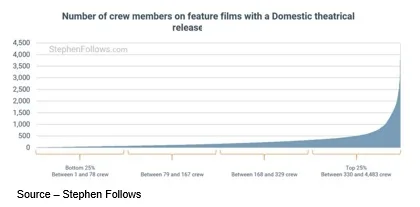
Most of the crafts people who work on the film/TV show projects, on set and remotely, are not full-time company employees but highly skilled/experienced freelancers who fill their annual calendar with project after project.
Depending on the project and how far behind schedule the film/show production is, delivery dates and time required for all of the tasks always seem to be underestimated. A-listers “encourage” the crew to make up the difference.
After all, it’s tough for project management to ask for more budget to meet the deadline.
It’s difficult to think about the glamour of working on a movie or TV show when the industry thinks 12- to 18-hour workdays are normal.
As a friend said when speaking about his current project production schedule, “The cost of living tired is so under appreciated.”

For years, guilds and unions have focused their attention/negotiations on the thing people are most concerned about … a living wage.
Overall, they’ve done a decent job.
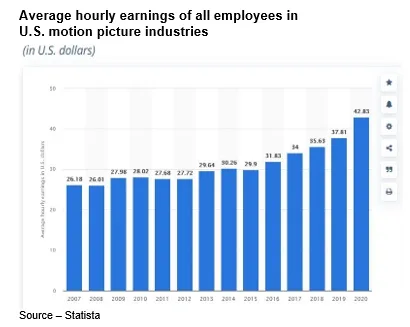
The average film crew will contain a wide variety of people that span a large number of skillsets and the average wage is rather meaningless.
In addition, it’s difficult for a crew member to move from one specialty to another to increase their breadth of experience and value on more projects as well as their income.
Most of the film crew/post positions are very siloed so people move up in seniority in a department rather than broaden their knowledge, expertise and income.
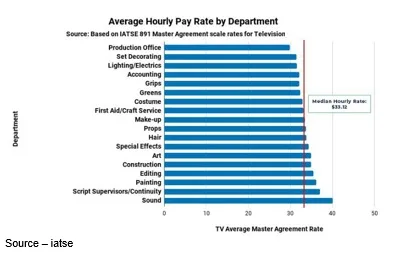
Visual effects (VFX), makeup, sound, stunts, camera, art and other folks focus on developing their expertise and reputation, so they become known as the “go-to” person for that task–and usually only that work.
Of course, unionized contract “rules” have something to do with what specialists can/can’t do on the set as well, but that’s another issue.
Back to the point … industry “average” salary doesn’t mean much. Nor does department average if you live in an expensive location such as Hollywood/LA, Toronto or London.
By holding the line, unions have been able to obtain excellent health care and benefits for mid to senior crew members.

But the work-life balance is … difficult.
It’s a long, hard and strangely tantalizing road.
After the past two on again/off again years, production/post people have demanded and are getting more.
- A real and meaningful rest period between leaving and returning from work, regardless of the craft or production
- A weekend rest period that allows for actual rest and time to spend with family and friends
- Effective penalties that truly discourage the systematic elimination of meal breaks and working straight into the weekends
The discussions of work/value/cost for project production have been going on for over 100 years but slowly, steadily progress has been made and new industry standards have been established around the globe in every major and minor production center.
Studios, producers and accountants will probably continue to accept 14-hour workdays without meaningful breaks as the industry standard
Change will be a constant, slow uphill battle.
It wasn’t that long ago that we added another “monitor” to the production team – the intimacy coordinator.
Mary Kay and Johnny were the first couple to be portrayed as a couple actually sleeping in the same bed (they were married in real life) back in 1947, but it was still the exception to the rule.
Ozzie and Harriett had twin beds and so did Lucy and Desi while children … just appeared.

Well known for her exercise videos in the ‘80s, Jamie Lee Curtis found it embarrassing to do her nude scenes in Trading Places and thought she got “a little too sexy” in the filming of True Lies.
The film industry veteran thought the Trading Places scene was totally tasteless while the True Lies scene was done without a rehearsal or even a choreographer.
Sharon Stone was far from happy with her work in Basic Instincts (including her infamous spread leg scene), but the project nearly destroyed her she said because of the nudity, her insecurity and predatory directors.
Today, intimacy coordinators ensure the well-being of actors in sex and intimate scenes so everyone on the set feels “comfortable.”
However, we feel a new issue has become even more prominent that the industry needs to address head-on–mental health and well-being.

Michaela Cole shined the spotlight on the issue with her I May Destroy You TV series when she hired British therapist Lou Platt to listen to and assist actors and technicians.
On-set and on-call therapists have increasingly been a part of projects to help everyone on the team – including VFX, editors, others – work through harrowing scenes that they have to watch again and again to complete the film/show to satisfy the edge-of-the-seat, action hungry viewer.
All of us have undoubtedly watched films and shows and afterward said, “jeez that was creepy/scary as H***” or “gawd that was so vicious, they had to feel it was real.”
But the thoughts quickly disappeared because while we only saw the project for an hour or so, the actors/crew lived the experience for weeks, months.
It turns out, they have affected people more than we realize.

Janet Leigh was never the same after her shower scream scene in Psycho.
It scared the crap out of the audience (oh come on, it did too!); but after that, she would never take showers, only baths, locked all the doors/windows in the house and always watched the bathroom door … just in case.
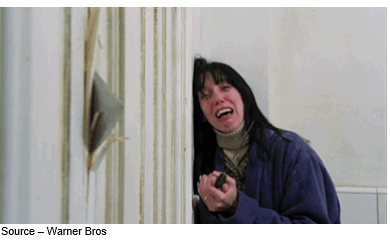
Shelley Duvall in The Shining had to reshoot the scene where she had to scream, cry and swing a baseball bat at her husband, Jack Nicholson, 127 times.
The now infamous door scene (voted the scariest in movie history) contributed to her hair loss and a nervous breakdown.
Today, almost every project is faced with the pressure of making up for lost time – cramming a year’s work into a few months.
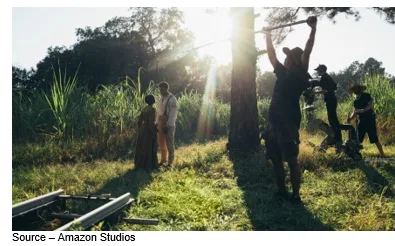
Producers, actors and therapists such as Kim Whyte who supported the cast and crew of Amazon’s The Underground Railroad, agree that the constant pressure is unsustainable.
While some therapists work off-site because of the possible stigma of being seen giving mental health support, Ms. Whyte prefers therapy while walking around.
She roams the set, chatting with actors and crew about anything and everything … sometimes serious, sometimes just idle talk.
Ms. Whyte noted that most of the cast and crew were bothered by having to reenact/capture the total concept of slavery but being able to talk about the weight and impact of the subject/storyline helped relieve the pressure, including how they dealt with it at home and in off hours.
Studios and producers are realizing that the dark scenes in films and shows as well as the project demands on everyone can be very emotionally taxing, affecting people in different ways … including suicide.
With the rush to return to the set and produce more content, research like that carried out by organizations like the U.K.’s Film and TV Charity are gaining increased attention … and action.
 Their report, Looking Glass 21 – available here – provides a baseline for the industry to take steps to improve conditions for everyone involved in the total content creation process, rather than focusing all of our attention on management and A-Listers.
Their report, Looking Glass 21 – available here – provides a baseline for the industry to take steps to improve conditions for everyone involved in the total content creation process, rather than focusing all of our attention on management and A-Listers.
It doesn’t provide the complete answer but as Joe said in A Fistful of Dollars, “A man’s life in these parts often depends on a mere scrap of information. Your brother’s own words.”
Identifying the issues is the first step in making the M&E industry a meaningful profession instead of a bunch of disposable freelancers.
# # #
Andy Marken – [email protected] – is an author of more than 700 articles on management, marketing, communications, industry trends in media & entertainment, consumer electronics, software, and applications. An internationally recognized marketing/communications consultant with a broad range of technical and industry expertise especially in storage, storage management and film/video production fields; he has an extended range of relationships with business, industry trade press, online media, and industry analysts/consultants.